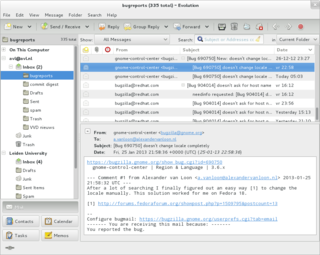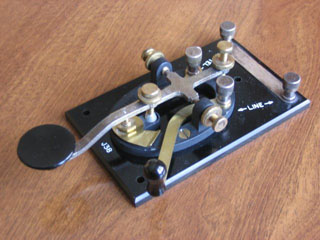This article needs additional citations for verification .(October 2009) |
End of message or EOM (as in "(EOM)" or "<EOM>") signifies the end of a message, often an e-mail message. [1]
This article needs additional citations for verification .(October 2009) |
End of message or EOM (as in "(EOM)" or "<EOM>") signifies the end of a message, often an e-mail message. [1]
The subject of an e-mail message may contain such an abbreviation to signify that all content is in the subject line so that the message itself does not need to be opened (e.g., "No classes Monday (EOM)" or "Midterm delayed <EOM>"). This practice can save the time of the receiver and has been recommended to increase productivity. [1] [2]
EOM can also be used in conjunction with no reply necessary, or NRN, to signify that the sender does not require (or would prefer not to receive) a response (e.g., "Campaign has launched (EOM/NRN)") or reply requested or RR to signify that the sender wishes a response (e.g., "Got a minute? (EOM/RR)"). These are examples of Internet slang.
EOM is often used this way, as a synonym to NRN, in blogs and forums online. It is often a snide way for commenters to imply that their message is so perfect that there can be no logical response to it. Or it can be used as a way of telling another specific poster to stop writing back.[ citation needed ]
EOM can also be defined as the final 3 buzzes of an alert of the Emergency Alert System to know when the alert is finished.
In earlier communications methods, an end of message ("EOM") sequence of characters indicated to a receiving device or operator that the current message has ended. In teleprinter systems, the sequence "NNNN", on a line by itself, is an end of message indicator. In several Morse code conventions, including amateur radio, the prosign AR (dit dah dit dah dit) means end of message.
In the original ASCII code, "EOM" corresponded to code 03 hex , which has since been renamed to "ETX" ("end of text"). [3]
In computing and telecommunication, a control character or non-printing character (NPC) is a code point in a character set, that does not represent a written symbol. They are used as in-band signaling to cause effects other than the addition of a symbol to the text. All other characters are mainly printing, printable, or graphic characters, except perhaps for the "space" character.

Electronic mail is a method of exchanging messages ("mail") between people using electronic devices. Email was thus conceived as the electronic (digital) version of, or counterpart to, mail, at a time when "mail" meant only physical mail. Email later became a ubiquitous communication medium, to the point that in current use, an email address is often treated as a basic and necessary part of many processes in business, commerce, government, education, entertainment, and other spheres of daily life in most countries.

Morse code is a method used in telecommunication to encode text characters as standardized sequences of two different signal durations, called dots and dashes, or dits and dahs. Morse code is named after Samuel Morse, one of the inventors of the telegraph.
Multipurpose Internet Mail Extensions (MIME) is an Internet standard that extends the format of email messages to support text in character sets other than ASCII, as well as attachments of audio, video, images, and application programs. Message bodies may consist of multiple parts, and header information may be specified in non-ASCII character sets. Email messages with MIME formatting are typically transmitted with standard protocols, such as the Simple Mail Transfer Protocol (SMTP), the Post Office Protocol (POP), and the Internet Message Access Protocol (IMAP).
The Simple Mail Transfer Protocol (SMTP) is an Internet standard communication protocol for electronic mail transmission. Mail servers and other message transfer agents use SMTP to send and receive mail messages. User-level email clients typically use SMTP only for sending messages to a mail server for relaying, and typically submit outgoing email to the mail server on port 587 or 465 per RFC 8314. For retrieving messages, IMAP is standard, but proprietary servers also often implement proprietary protocols, e.g., Exchange ActiveSync.
A signature block is a personalized block of text automatically appended at the bottom of an email message, Usenet article, or forum post.
In computing, a handshake is a signal between two devices or programs, used to, e.g., authenticate, coordinate. An example is the handshaking between a hypervisor and an application in a guest virtual machine.
The Q-code is a standardised collection of three-letter codes that each start with the letter "Q". It is an operating signal initially developed for commercial radiotelegraph communication and later adopted by other radio services, especially amateur radio. To distinguish the use of a Q-code transmitted as a question from the same Q-code transmitted as a statement, operators either prefixed it with the military network question marker "INT" or suffixed it with the standard Morse question mark UD.

A telegraph key is a specialized electrical switch used by a trained operator to transmit text messages in Morse code in a telegraphy system. Keys are used in all forms of electrical telegraph systems, including landline telegraphy and radio telegraphy. An operator uses the telegraph key to send electrical pulses of two different lengths: short pulses, called dots or dits, and longer pulses, called dashes or dahs. These pulses encode the letters and other characters that spell out the message.
An email address identifies an email box to which messages are delivered. While early messaging systems used a variety of formats for addressing, today, email addresses follow a set of specific rules originally standardized by the Internet Engineering Task Force (IETF) in the 1980s, and updated by RFC 5322 and 6854. The term email address in this article refers to just the addr-spec in Section 3.4 of RFC 5322. The RFC defines address more broadly as either a mailbox or group. A mailbox value can be either a name-addr, which contains a display-name and addr-spec, or the more common addr-spec alone.
Various anti-spam techniques are used to prevent email spam.
Sender Policy Framework (SPF) is an email authentication method designed to detect forging sender addresses during the delivery of the email. SPF alone, though, is limited to detecting a forged sender claim in the envelope of the email, which is used when the mail gets bounced. Only in combination with DMARC can it be used to detect the forging of the visible sender in emails, a technique often used in phishing and email spam.
A bounce message or just "bounce" is an automated message from an email system, informing the sender of a previous message that the message has not been delivered. The original message is said to have "bounced".
Many email clients now offer some support for Unicode. Some clients will automatically choose between a legacy encoding and Unicode depending on the mail's content, either automatically or when the user requests it.
A challenge–response system is a type of spam filter that automatically sends a reply with a challenge to the (alleged) sender of an incoming e-mail. It was originally designed in 1997 by Stan Weatherby, and was called Email Verification. In this reply, the purported sender is asked to perform some action to assure delivery of the original message, which would otherwise not be delivered. The action to perform typically takes relatively little effort to do once, but great effort to perform in large numbers. This effectively filters out spammers. Challenge–response systems only need to send challenges to unknown senders. Senders that have previously performed the challenging action, or who have previously been sent e-mail(s) to, would be automatically whitelisted.

Procedural signs or prosigns are shorthand signals used in Morse code radio telegraphy procedure, for the purpose of simplifying and standardizing radio communication protocol. They are separate from Morse code abbreviations, which consist mainly of brevity codes that convey messages to other parties with greater speed and accuracy.
Email forwarding generically refers to the operation of re-sending an email message delivered to one email address to one or more different email addresses.
Backscatter is incorrectly automated bounce messages sent by mail servers, typically as a side effect of incoming spam.
EmailTray is a lightweight email client for the Microsoft Windows operating system. EmailTray was developed by Internet Promotion Agency S.A., a software development d.